The Americas, Europe, Asia, and Africa are some of the continents where ducks with white heads live.
Some species are found on multiple continents while others only inhabit small areas without migrating.
Ducks in North America are most likely to have white heads only in the case of males, as females are dull-colored.
Ducks in South America are more likely to show white heads both for males and females.
The white color of the heads is typically matched by darker body plumage. Here are some of the most representative species that have black heads for either males or females or both sexes.
Table of Contents
1. Bufflehead
Some of the most common whitehead ducks that stand out are Buffleheads (Bucephala albeola).
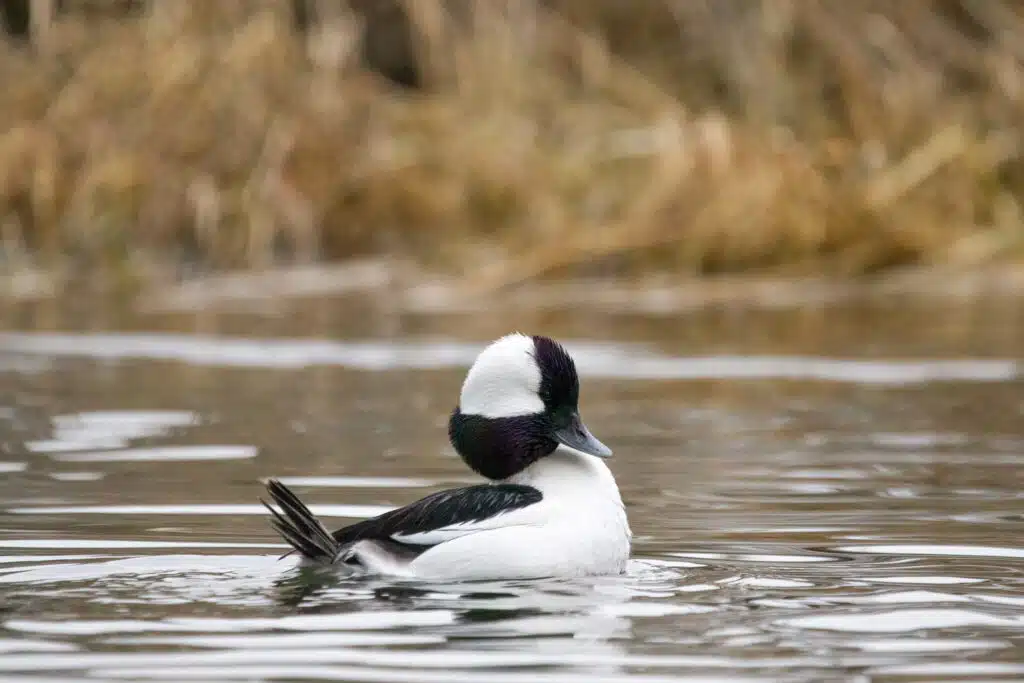
These types of ducks have mostly white or partly white head coloring, depending on the sexes.
Furthermore, additional colors on the head help the species stand out among ducks.
Males have the largest white sections on the head compared to females. The male Bufflehead also has green and purple colors with iridescence on the head.
White sections are specific to the sides and back of the head while black, purple, and green areas are seen on the crown and the face.
Black and white plumage completes the multicolored appearance of male Buffleheads.
Smaller white cheek sections are specific to females which have dark gray to black crests and backs while the underside is bright gray.
Interesting fact – female Buffleheads repurpose the same nest every year.
Distribution – North America, Mexico
2. Hooded Merganser
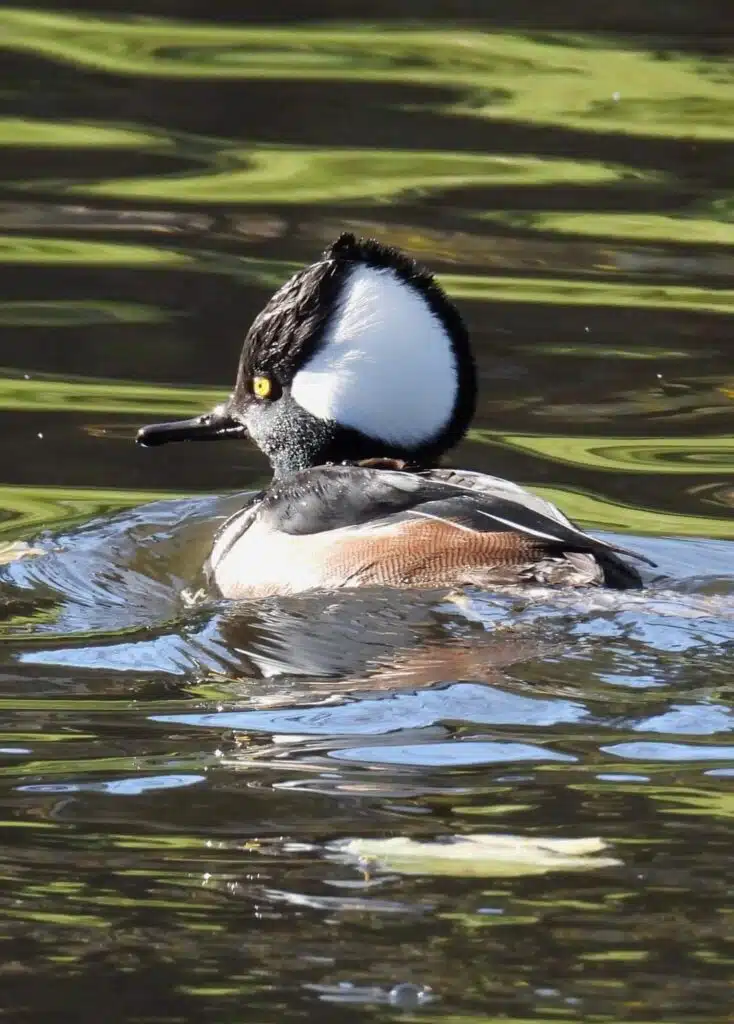
Atypical appearance is specific to Hooded Mergansers (Lophodytes cucullatus). This North American duck comes with white heads in the case of males and with crests both for males and females.
One of the confusing aspects about the head of the species is based on their ability to move the crest up and down.
Males have mostly white heads, particularly on the sides. The crest and face of the species are mostly black.
This is also a species where the monochrome head of males are backed by bright yellow colors of the eyes.
Females are less colorful but still intriguing. They have a fluffy crest which can be raised or lowered. The head of females is gray and brown, without the large considerable white sections seen on male heads.
Interesting fact – Hooded Mergansers are predators, not interested in plants.
Distribution – North America
3. Long-tailed Duck
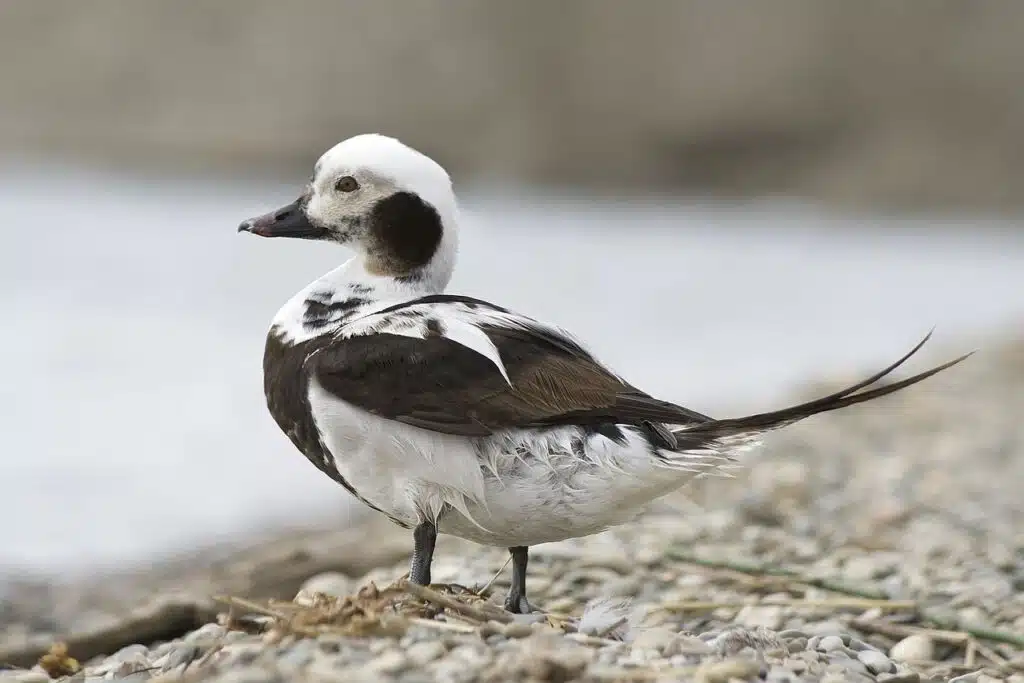
A pattern of black and white or white and brown is seen on Long-tailed Ducks (Clangula hyemalis). Both males and females have considerable white sections across the heads.
Males have larger white sections across the head and body compared to females.
They have white and grey heads and crests with a black area around the bill and at the back of the head.
Females have white to gray faces with bright brown crests and areas at the back of the head.
While males are mostly white, females are mostly dull brown without any white sections across the back, wings, or underbelly.
Interesting fact – these ducks live far from large human settlements across Northern tundras.
Distribution – Northern parts of North America, Europe, and Asia
4. Muscovy Duck

Large color variation is specific to Muscovy Ducks (Cairina moschata). These are bird species with white heads, black heads, or even purple heads.
The color changes these birds go through as well as their location impacts how they look.
A white head with a red face is specific to the white head morph of the species.
A black-and-white color combination with specific red exposed skin patches is specific to these types of ducks.
While they can use this highly contrasting appearance to attract mates or to deter predators, these types of ducks are known to feed on plants in water and insects.
Interesting fact – Muscovy Ducks mainly have aquatic predators as they remain on the water during the day and the night.
Distribution – North America, Europe
5. King Eider
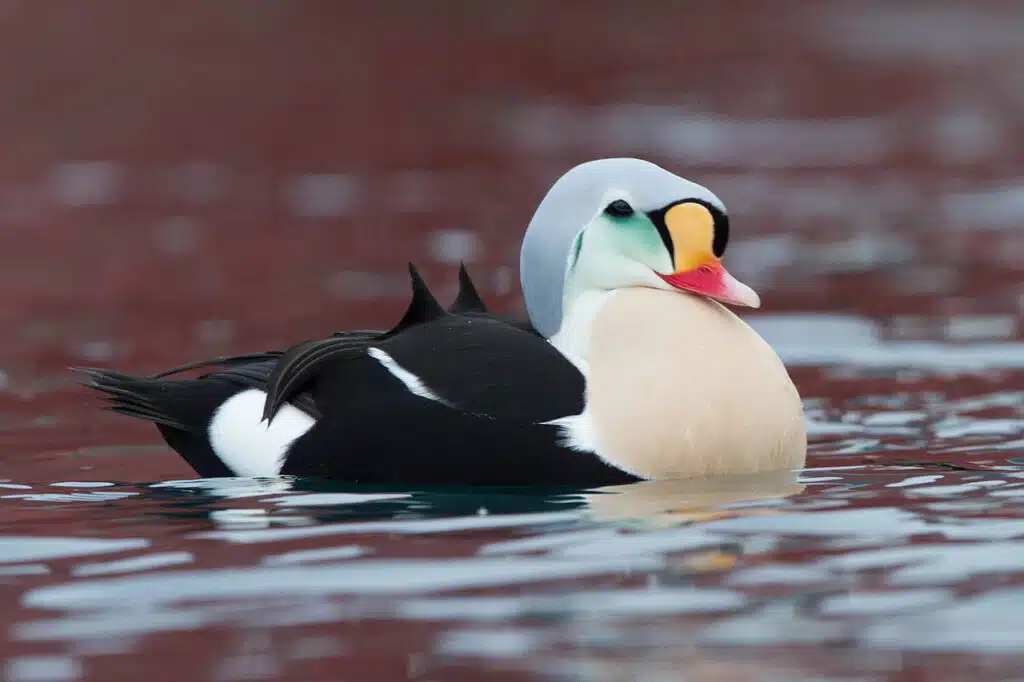
Much of the appearance of male King Eiders (Somateria spectabilis) doesn’t signal these ducks to be similar to females.
They have multicolored heads while females have dull brown heads.
Bright blue nuances are specific to the head of the male, together with considerable white, yellow, and orange sections.
There’s a fine black line separating the blue areas of the head from the rest of the colors as well.
A species of the cool Northern territories, King Eiders are among the species that are also known for male vocalizations.
These are vocalizations that may easily be confused with dove sounds.
Interesting fact – hundreds of thousands of King Eiders spend winters together in flocks.
Distribution – Northern North America and Europe, Greenland
6. Steller’s Eider
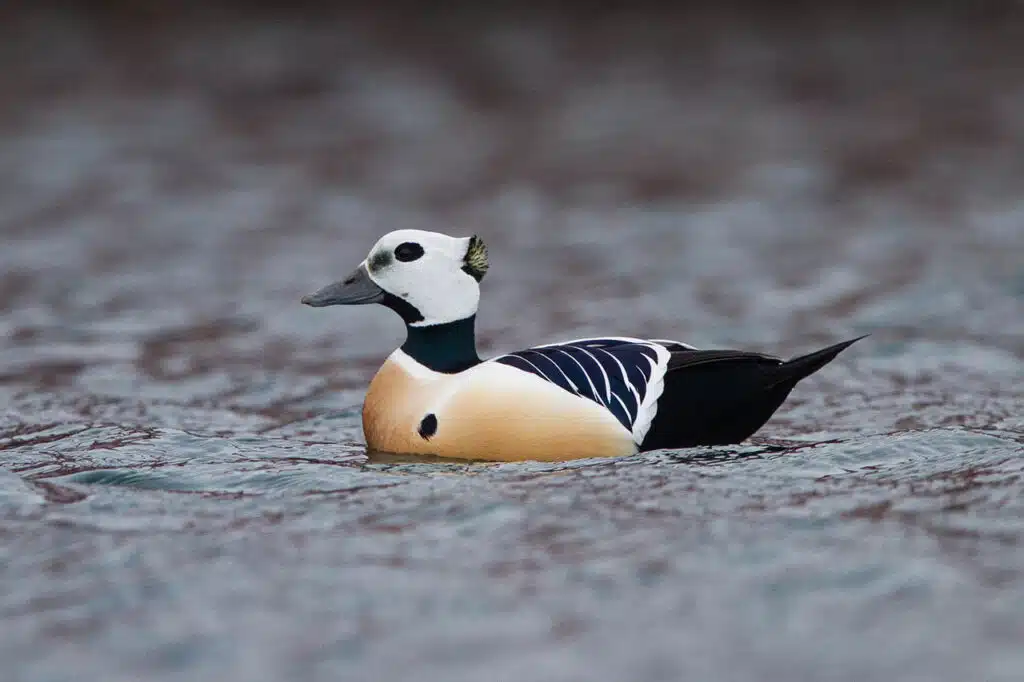
A species of the tundra, Steller’s Eiders (Polysticta stelleri) are some of the most colorful and contrasting ducks with white heads.
It’s the males of the species that change into multicolored plumage going into the breeding season.
They get a white head with a black neck and black rings around the eyes. Green-black plumage is also specific to the back of their heads.
Red-brown underbellies and black plus white wings are specific to these species.
Females have brown, cinnamon, or even dark green nuances across without a white head to match the appearance of males.
While highly specific to tundra habitats, these ducks retreat to warmer coastal areas in the winter.
Interesting fact – males change their head color from black to white going out of the winter.
Distribution – Arctic regions
7. Spectacled Eider
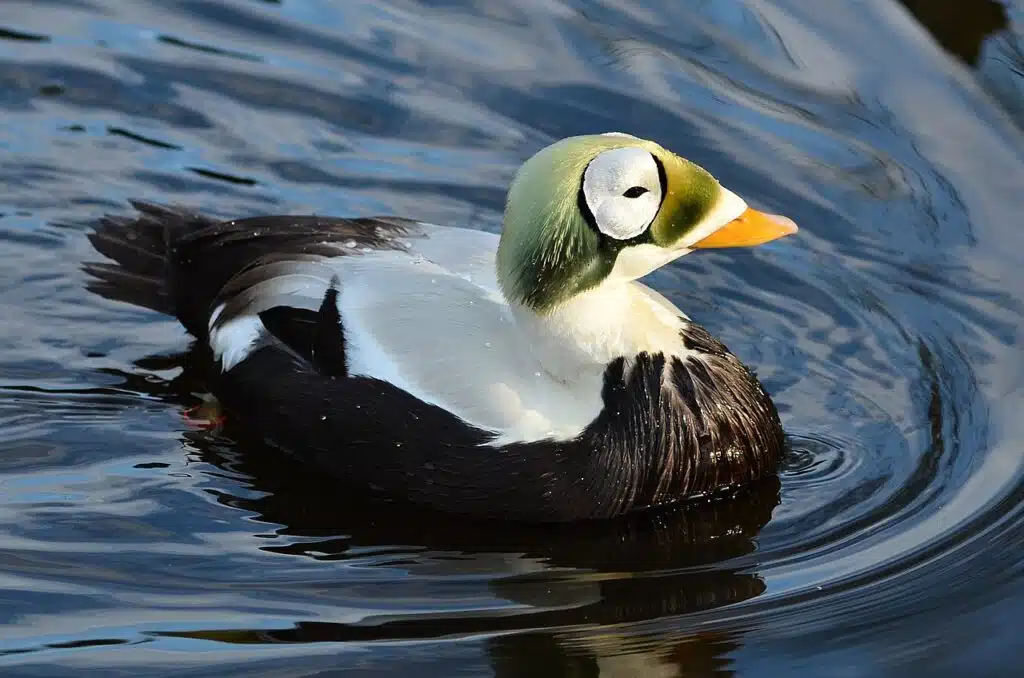
Named after the appearance of their faces, these ducks (Somateria fischeri) may appear as spectacled.
They are known for their vast coloring differences between males and females.
The male Spectacled Eider is considerably brighter than females. Females are dark brown with a matching brown and bright brown head.
Males have white face sections on a green-to-yellow head. The white sections make the species look like wearing glasses.
Black sections border the area between the green and the white sections of the face while the beak is orange.
White is also dominating the back and wing feathers.
Interesting fact – a diving species, these ducks can remain submerged longer than other diving ducks.
Distribution – Alaska
8. White-headed Duck
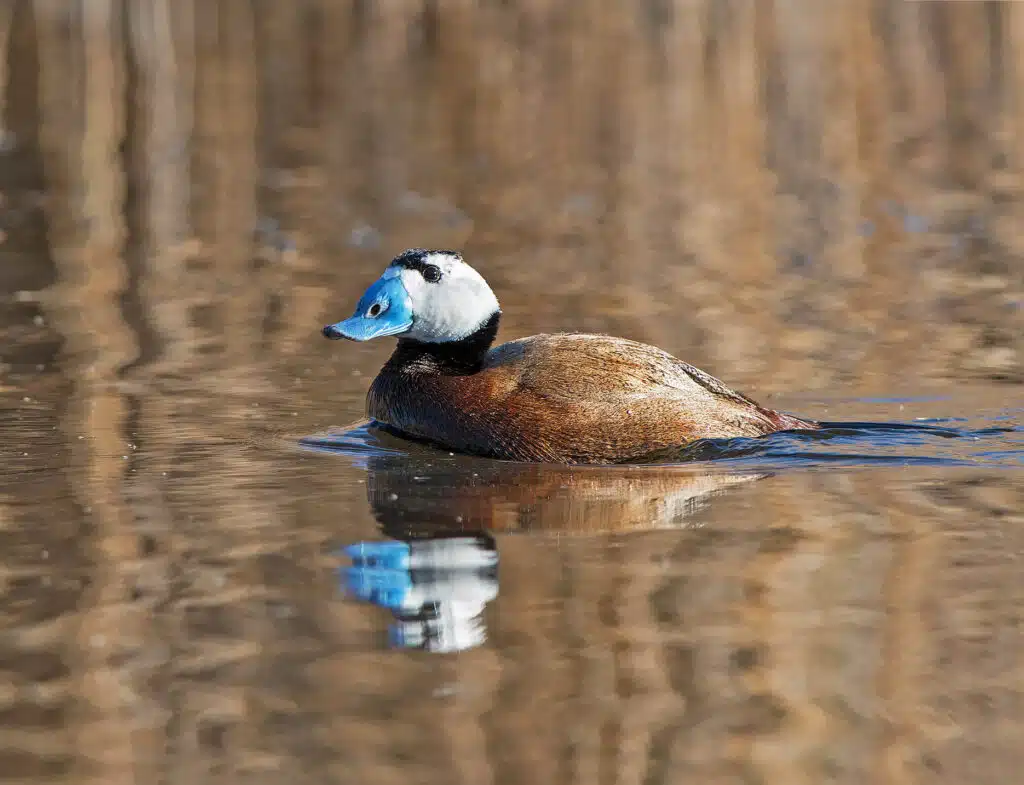
A considerable white section covers the face of both male and female White-headed Ducks (Oxyura leucocephala).
These are the types of ducks that show color changes going into the breeding season. Males turn their white sections to blue sections for higher breeding success.
Males take on an additional black section on the crown while their beak turns dark blue.
Female White-headed Ducks maintain their white faces while the crown is bright brown. Both males and females have brown-gray plumage.
The status of the ducks is impacted by its region. Some White-headed Ducks are migratory while others are partly-migratory.
There are even White-headed Ducks that don’t migrate at all.
Interesting fact – White-headed ducks can swim underwater.
Distribution – Western Asia, Southern Europe, North Africa
9. Torrent Duck
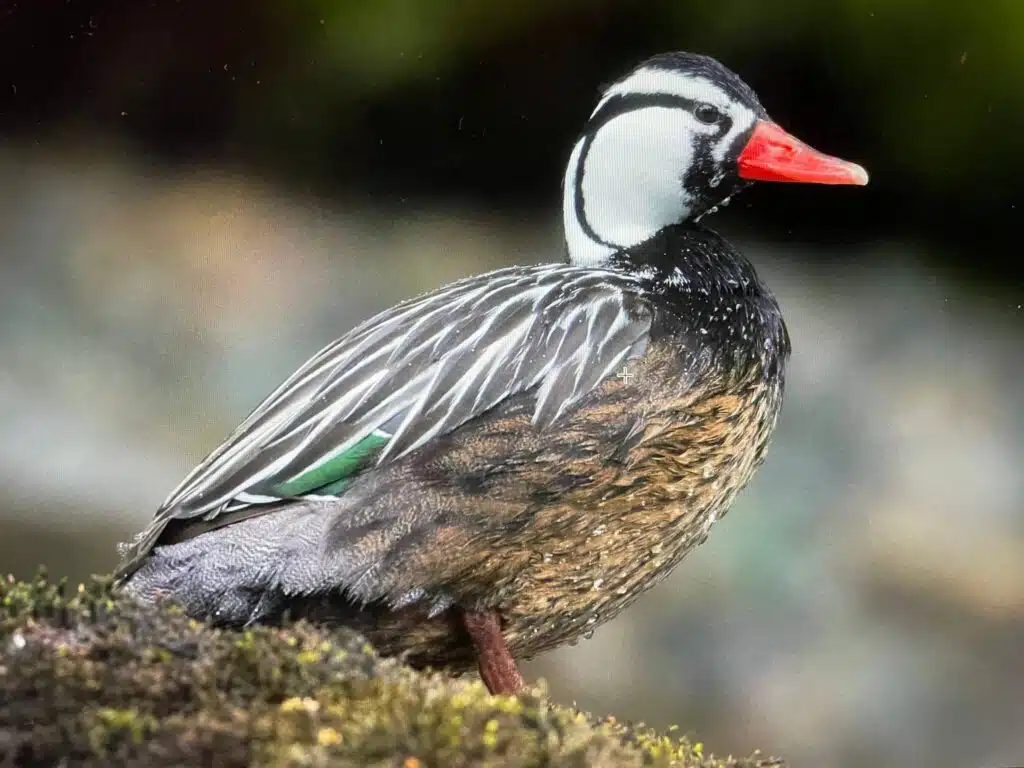
A mostly white head is specific to male Torrent Ducks (Merganetta armata). These types of ducks are dominated by a contrasting head white and black color combination.
Mostly white, the head of the species has a black crest with black lateral stripes.
The neck is also white while the underbelly is white with gray streaks.
Females are considerably darker and smaller than males. They show a gray head with mustard-yellowface nuances which are seen further down the chest and belly.
These types of ducks can also be heard, if not spotted. A high-pitched call is specific to these ducks.
Males and females make specific calls which resemble whistling.
Interesting fact – male Torrent Ducks have variable head coloring depending on their subspecies.
Distribution – Western South America
10. South African Shelduck
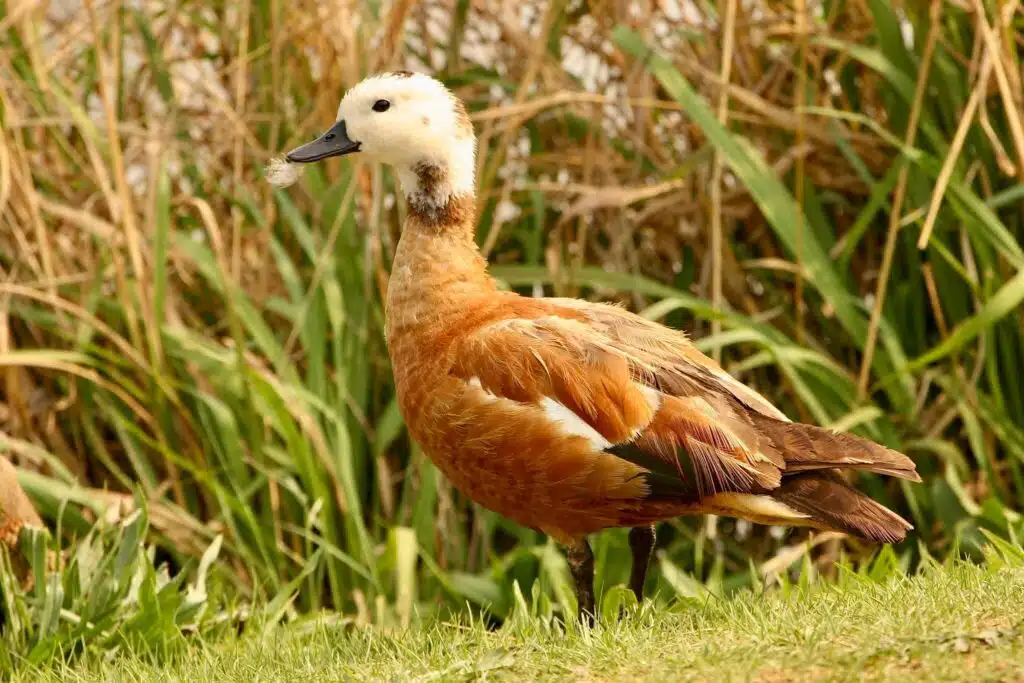
A species with variable plumage depending on the austral winter, South African Shelducks (Tadorna cana) are among the most colorful species in the world.
These are the types of ducks that show a white head in the case of females as male ducks have dull gray heads.
The female South African Shelduck has a white face with partially gray crests and areas behind the head.
The rest of the plumage is red-brown with green sheen nuances, white nuances, and additional gray feathers towards the tips of the wings.
A protected species in Africa, these types of ducks only change plumage in the case of males.
Interesting fact – South African Shelducks also lay pearl white eggs.
Distribution – Namibia, South Africa
11. Radjah Shelduck
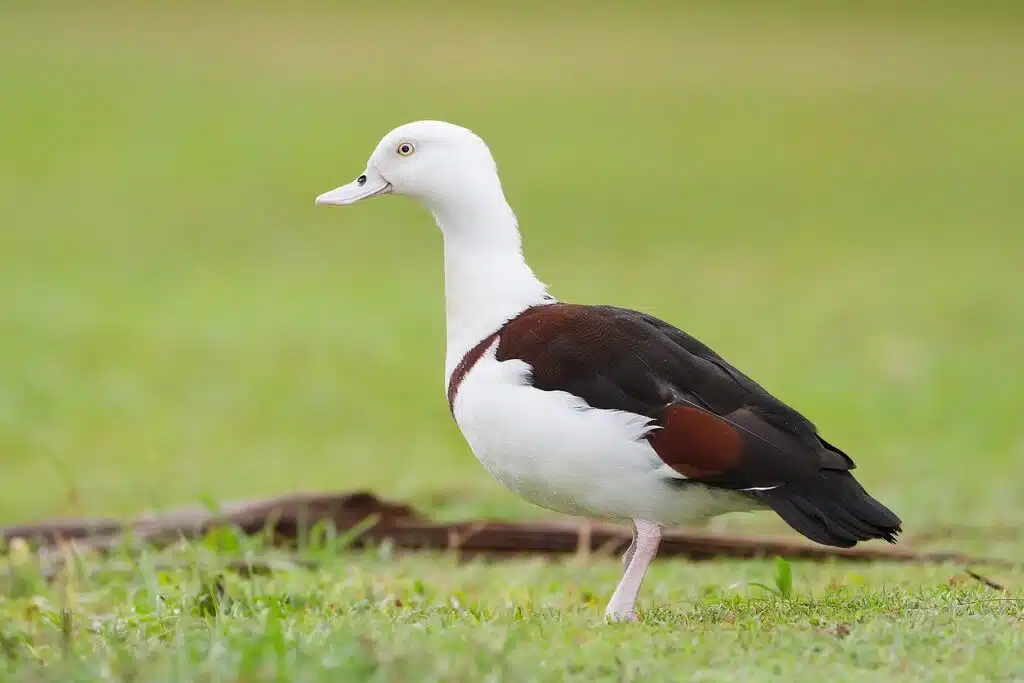
A mostly white head is specific to male Radjah Shelducks (Radjah radjah).
These types of ducks are dominated by monochromatic black-and-white colors. They show a white head, white, necks, and white bellies.
The wings of the species are mostly black with long black feathers.
Dominated by white nuances, these types of ducks are also among the few ducks with white beaks and white eyes.
Its habitat has little influence on the appearance of the ducks as they live in different areas such as beaches or forests.
Interesting fact – Radjah Shelducks are often spotted in areas with plenty of algae.
Distribution – Australia, New Guinea
12. Ruddy Duck

Male Ruddy Ducks (Oxyura jamaicensis) have mostly white and have mostly white and black heads. Their faces are the white section while the cap is typically black or dark brown.
A blue beak is a further characteristic of male Ruddy Ducks.
Chestnut colors are specific to the male duck while females come in different gray combinations.
The female duck has bright white-gray sections on the face instead of the pure white nuance seen on males.
Ruddy Ducks show a highly aggressive and even invasive status outside of their native range.
In Europe, this species also shows a high desire for breeding with other ducks. As a result, Ruddy Duck populations are rapidly increasing around the world.
Interesting fact – female ducks lay up to 15 white or pale green eggs after breeding.
Distribution – Europe, North America
13. Common Eider
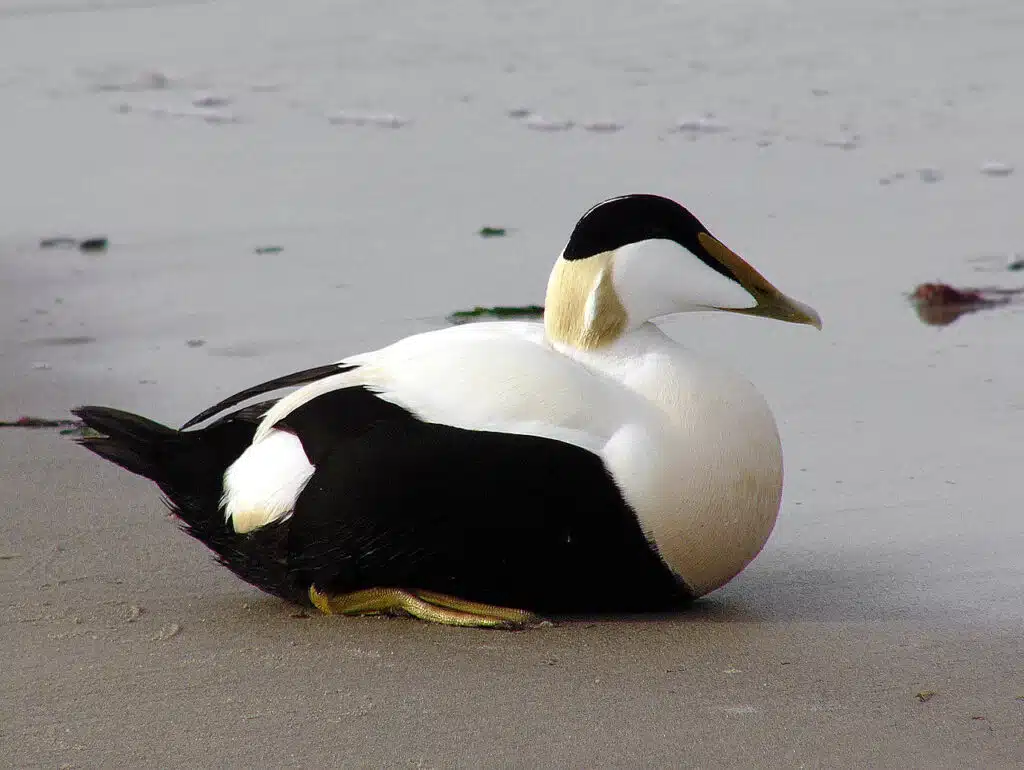
A white head is specific to the male Common Eider (Somateria mollissima). This is a species with considerable white areas across its head, belly, and wings.
The head is mostly white with a black cap and an off-white beak.
Females have a gray-brown color with similar nuances across the head, neck, and belly.
While not the fastest ducks in North America, Common Eiders can still fly at top speeds. They easily navigate vast coastal areas as they have adapted to cool Arctic areas.
Common Eiders fight off cold weather by using down from females to line their nests for warmth.
However, female Common Eiders can also show an almost invasive tendency to lay eggs.
They prefer to lay eggs in the nest of other species if they find a suitable nest in their range as opposed to building their nests from scratch.
Interesting fact – up to 2 million Common Eiders are believed to exist around the world.
Distribution – temperate Arctic regions
14. White-faced Whistling Duck

From a young age, White-faced Whistling Ducks (Dendrocygna viduata) have white faces while the rest of the head is bright gray.
As they grow, these ducks eventually become entirely white-headed. The crown and the face are bright white while the back of the head is black. A combination of black and white patterns is also seen on its beak.
While the head is mostly white, these ducks show a vivid red chest which makes them stand out.
Gray, brown, white, and yellow nuances are further seen across the body and the wings.
The name of the species is inspired both by the call of the individual duck and by the loud call of their flocks.
Whistling noises made by these ducks are rarely seen in small flocks. They prefer to live together, in their thousands.
Their colonies may easily be spotted at different times of the year as these ducks don’t migrate.
Small local movements may sometimes be confirmed around the world either due to impact on the environment such as pollution or to lack of food.
Interesting fact – there are unconfirmed White-faced Whistling Ducks sightings in Florida.
Distribution – South America, Africa
15. Puna Teal

A native duck of The Andes, Puna Teal ducks (Spatula puna) have some of the most distinguishing physical traits.
These ducks show a common white face in the case of males and females. Their heads are combined with black crowns while their beaks have unique color combinations.
A blue beak is specific to the species but its central black stripe is very rare.
These ducks have brown plumage with white patterns or stripes covering the chest and the wings.
Another rare trait of Puna Teals is that both males and females care for their young.
The species is more adaptable to walking on land than other ducks which means males and females may be spotted with their ducklings on land more.
Even more, females are known to pick out specific areas of land with vegetation to lay their eggs with an extra layer of protection.
Interesting fact – male and female Puna Teals have a similar appearance, unlike many other ducks.
Distribution – Bolivian and Peruvian Andes
16. White-cheeked Pintail

The White-cheeked Pintail (Anas bahamensis) is among the most common ducks in The Caribbean and South America.
Its presence has also been noted in areas of The United States such as Florida, but in lower numbers.
Its believed that White-cheeked Pintail populations are increasing in The Americas due to the capacity of the species to adapt to its habitat. It lives both in saline and freshwater habitats.
This is also a species where the head is mostly white throughout the year.
A white face is specific to these ducks which have bright brown crowns.
The chest, underbelly, and wings also have a similar bright brown nuance.
Black spots and marks are seen on the brown plumage of the species. Its white and brown head is further distinguished by a red and black beak.
White-cheeked Pintails are red-beak ducks with matching black and red eyes.
Interesting fact – White-cheeked Pintails are among the few ducks in North America with similar male and female appearances.
Distribution – The Caribbean, South America, Florida
17. White-headed Steamer-Duck

A native species of Argentina, White-headed Steamer-Ducks (Tachyeres leucocephalus) live in a small area of the country’s Atlantic Coast.
A stretch of a few hundred miles is the home of these ducks which are only found here. The species is constantly monitored as the populations are low.
It’s believed there are less than 4.000 White-headed Steamer-Duckers in their natural habitat.
This is a species with a white head and brown plumage. Only males have a white head and a contrasting orange beak.
Females have gray heads with white stripes and are dominated by gray nuances.
The beak of females is also only partly orange and mostly gray.
The female of the species looks similar to the female Flying Steamer Duck which is also one of the reasons these species are often seen in communal flocks.
Interesting fact – these types of ducks cannot fly and use fast swimming to escape predators.
Distribution – San Jorge Gulf in Argentina